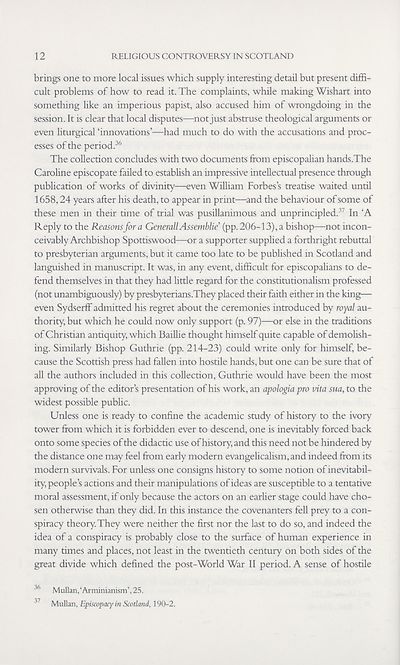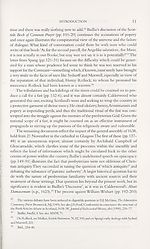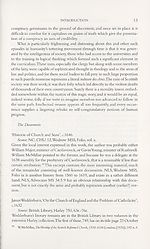Series 5 > Religious Controversy in Scotland 1625-1639
(27) Page 12
Download files
Complete book:
Individual page:
Thumbnail gallery: Grid view | List view

12
RELIGIOUS CONTROVERSY IN SCOTLAND
brings one to more local issues which supply interesting detail but present diffi¬
cult problems of how to read it. The complaints, while making Wishart into
something like an imperious papist, also accused him of wrongdoing in the
session. It is clear that local disputes—not just abstruse theological arguments or
even liturgical ‘innovations’—had much to do with the accusations and proc¬
esses of the period.36
The collection concludes with two documents from episcopaHan hands.The
Caroline episcopate failed to establish an impressive intellectual presence through
publication of works of divinity—even William Forbes’s treatise waited until
1658,24 years after his death, to appear in print—and the behaviour of some of
these men in their time of trial was pusillanimous and unprincipled.37 In ‘A
Reply to the Reasons for a Generali Assemblie’ (pp. 206-13), a bishop—not incon¬
ceivably Archbishop Spottiswood—or a supporter supplied a forthright rebuttal
to presbyterian arguments, but it came too late to be published in Scotland and
languished in manuscript. It was, in any event, difficult for episcopahans to de¬
fend themselves in that they had little regard for the constitutionalism professed
(not unambiguously) by presbyterians.They placed their faith either in the king—
even Sydserff admitted his regret about the ceremonies introduced by royal au¬
thority, but which he could now only support (p. 97)—or else in the traditions
of Christian antiquity, which Baillie thought himself quite capable of demohsh-
ing. Similarly Bishop Guthrie (pp. 214-23) could write only for himself, be¬
cause the Scottish press had fallen into hostile hands, but one can be sure that of
all the authors included in this collection, Guthrie would have been the most
approving of the editor’s presentation of his work, an apologia pro vita sua, to the
widest possible public.
Unless one is ready to confine the academic study of history to the ivory
tower from which it is forbidden ever to descend, one is inevitably forced back
onto some species of the didactic use of history, and this need not be hindered by
the distance one may feel from early modern evangelicalism, and indeed from its
modern survivals. For unless one consigns history to some notion of inevitabil¬
ity, people’s actions and their manipulations of ideas are susceptible to a tentative
moral assessment, if only because the actors on an earlier stage could have cho¬
sen otherwise than they did. In this instance the covenanters fell prey to a con¬
spiracy theory. They were neither the first nor the last to do so, and indeed the
idea of a conspiracy is probably close to the surface of human experience in
many times and places, not least in the twentieth century on both sides of the
great divide which defined the post-World War II period. A sense of hostile
36 Mullan,‘Arminianism’,25.
37 Mullan, Episcopacy in Scotland, 190-2.
RELIGIOUS CONTROVERSY IN SCOTLAND
brings one to more local issues which supply interesting detail but present diffi¬
cult problems of how to read it. The complaints, while making Wishart into
something like an imperious papist, also accused him of wrongdoing in the
session. It is clear that local disputes—not just abstruse theological arguments or
even liturgical ‘innovations’—had much to do with the accusations and proc¬
esses of the period.36
The collection concludes with two documents from episcopaHan hands.The
Caroline episcopate failed to establish an impressive intellectual presence through
publication of works of divinity—even William Forbes’s treatise waited until
1658,24 years after his death, to appear in print—and the behaviour of some of
these men in their time of trial was pusillanimous and unprincipled.37 In ‘A
Reply to the Reasons for a Generali Assemblie’ (pp. 206-13), a bishop—not incon¬
ceivably Archbishop Spottiswood—or a supporter supplied a forthright rebuttal
to presbyterian arguments, but it came too late to be published in Scotland and
languished in manuscript. It was, in any event, difficult for episcopahans to de¬
fend themselves in that they had little regard for the constitutionalism professed
(not unambiguously) by presbyterians.They placed their faith either in the king—
even Sydserff admitted his regret about the ceremonies introduced by royal au¬
thority, but which he could now only support (p. 97)—or else in the traditions
of Christian antiquity, which Baillie thought himself quite capable of demohsh-
ing. Similarly Bishop Guthrie (pp. 214-23) could write only for himself, be¬
cause the Scottish press had fallen into hostile hands, but one can be sure that of
all the authors included in this collection, Guthrie would have been the most
approving of the editor’s presentation of his work, an apologia pro vita sua, to the
widest possible public.
Unless one is ready to confine the academic study of history to the ivory
tower from which it is forbidden ever to descend, one is inevitably forced back
onto some species of the didactic use of history, and this need not be hindered by
the distance one may feel from early modern evangelicalism, and indeed from its
modern survivals. For unless one consigns history to some notion of inevitabil¬
ity, people’s actions and their manipulations of ideas are susceptible to a tentative
moral assessment, if only because the actors on an earlier stage could have cho¬
sen otherwise than they did. In this instance the covenanters fell prey to a con¬
spiracy theory. They were neither the first nor the last to do so, and indeed the
idea of a conspiracy is probably close to the surface of human experience in
many times and places, not least in the twentieth century on both sides of the
great divide which defined the post-World War II period. A sense of hostile
36 Mullan,‘Arminianism’,25.
37 Mullan, Episcopacy in Scotland, 190-2.
Set display mode to:
![]() Universal Viewer |
Universal Viewer | ![]() Mirador |
Large image | Transcription
Mirador |
Large image | Transcription
Images and transcriptions on this page, including medium image downloads, may be used under the Creative Commons Attribution 4.0 International Licence unless otherwise stated. ![]()
| Scottish History Society volumes > Series 5 > Religious Controversy in Scotland 1625-1639 > (27) Page 12 |
|---|
| Permanent URL | https://digital.nls.uk/127328289 |
|---|
| Description | Over 180 volumes, published by the Scottish History Society, containing original sources on Scotland's history and people. With a wide range of subjects, the books collectively cover all periods from the 12th to 20th centuries, and reflect changing trends in Scottish history. Sources are accompanied by scholarly interpretation, references and bibliographies. Volumes are usually published annually, and more digitised volumes will be added as they become available. |
|---|


